Rabbit Hunt
- E. Martin Hennings, American, 1886-1956
- Born: New Jersey
- Work Locations: Taos, NM
E. Martin Hennings was born in New Jersey and spent his childhood in Chicago. Inspired by a visit to the Art Institute of Chicago, he decided to become an artist at the young age of thirteen. He enrolled in classes at the Art Institute and eventually graduated with honors. He also studied painting at the Royal Academy in Munich. In 1917, Hennings visited Taos, New Mexico, on a summer trip sponsored by Chicago Mayor Carter H. Harrison, Jr. While there, Hennings found inspiration in the subject matter of the American West. He made Taos his home in 1921, joined the Taos Society of Artists in 1924, and remained there until his death in 1956.
Hennings did most of his paintings outdoors but would often add finishing touches in his studio. He used many thin layers of paint, which required lengthy drying periods, so he would work on several paintings at a time. Hennings would never sign his name until he was completely satisfied with his work.
Hennings was drawn to both the landscape and the people of the Taos area. The bright sunlight of New Mexico inspired his colorful palette. He commented in his later years, “I have been working in Taos many years and I think that should prove that I like it here; the country, the mountains with their canyons and streams, the sage beneath the clouded skies, the adobe village with its Spanish people and of course the Taos Pueblo with its Indians. Their life—domestic and agricultural—with all the color and romance of their dress and history.”
Hennings knew some of his American Indian subjects very well, and he was even known to change a painting in response to their concerns. He and his wife lived on a reservation for a while, and Hennings shows Indians as he knew them—as people living in the modern world, hunting with rifles and clothed in individual ways, including one fellow in a tennis sweater. “[I]n figure subjects I think I find my greatest inspiration—subjects which you have grown to know from experience and subjects which the imagination brings forth.”
Details
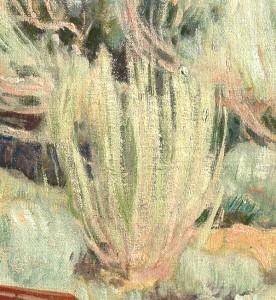
Vertical Patterns
The vertical patterns are most noticeable in the blanket and the braids worn by the men, but Hennings also used the patterns in nature: in the sky, the horse’s tail, and in the sagebrush.

Light
Dramatic light, bright color, and pattern activate this rather static scene. In spite of the dark, stormy sky, the sun throws hard shadows in the foreground. Bright light falls on the three men and the horse in the foreground of the painting, but the title subject, the dead rabbit, is obscured in dark shadows.
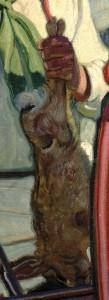
The Rabbit
Though the rabbit is hidden in the shadows, Hennings uses several techniques to signal its presence. All the men seem to have their attention focused on the rabbit and their rifles point to their recent kill. The vertical lines play another role here; if you follow the rider’s braids to the horse’s reigns to the other set of braids, your eye is led directly to the rabbit.
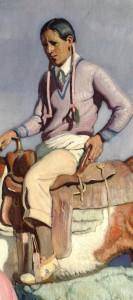
The People
Three men have a bold presence in Rabbit Hunt. Though they have quite individualized faces, we don’t know exactly who they are. Notice how each man is clothed in an individual way. The rider, for example is wearing a cross-cultural combination of trousers, a cuffed shirt, a tennis sweater, and moccasins.
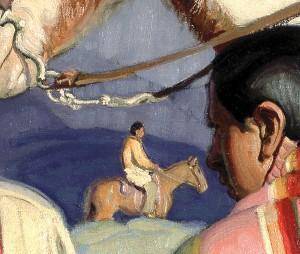
The In-between Spaces
The diamond shape under the horse’s neck creates a frame for another horse and rider. At first glance there is only one horse present, but look a little closer and you’ll see there are three in this painting.

The Striped Blanket
Striped blankets were used all the time, but Hennings would have selected the colors, pattern, and position of the blanket to suit his vision for the scene.
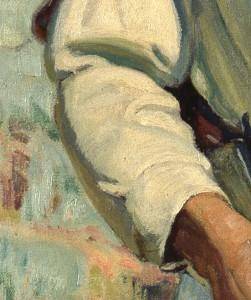
Colors in Unexpected Places
Bright colors are found throughout this painting in the highlights and shadows. Notice the bright red-orange near the horse’s hind leg, the yellow contours on the shadowed white clothing, and the light blue edges of the sagebrush in the center.
More Resources
Websites
Taos and Santa Fe Painters: Ernest Martin Hennings
A site dedicated to the Taos and Santa Fe painters, including history, artist biographies, collection and exhibition information.
Books
Bickerstaff, Laura M. Pioneer Artists of Taos. Denver, CO: Old West Publishing Co., 1983.
An explanation of the Taos Society of Artists as an organization as well as discussions of the important artists themselves.
C.M. Russell Museum. Masters of the Taos Tradition: The Gerald Peters Collection. Great Falls, Montana: C.M. Russell Museum, 1993.
A collection of major artists of the Taos tradition, short descriptions and images of artworks.
Bach, Cile M., and Marlene Chambers, eds. Picturesque Images from Taos and Santa Fe. Denver, CO: The Denver Art Museum, 1974.
An exhibition catalogue of artworks by Taos and Santa Fe artists. Hennings is discussed on pages 104-108.
Nelson, Mary Carroll. The Legendary Artists of Taos. New York: Watson-Guptill Publications, 1980, pp. 100-107.
The essay within this book, “E. Martin Hennings: A Love Story,” discusses the life and work of the artist.
White, Robert R. '"E. Martin Hennings," Pioneer Artists of Taos, Laura M. Bickerstaff. (Denver: Sage Books, 1955; rev, and expanded ed., Denver: Old West Publishing Co., 1983), p. 203A look at the evolution of E. Martin Hennings's artistic career.
Funding for object education resources provided by a grant from the Morgridge Family Foundation. Additional funding provided by the William Randolph Hearst Endowment for Education Programs, and Xcel Energy Foundation. We thank our colleagues at the University of Denver Morgridge College of Education.
The images on this page are intended for classroom use only and may not be reproduced for other reasons without the permission of the Denver Art Museum. This object may not currently be on display at the museum.
